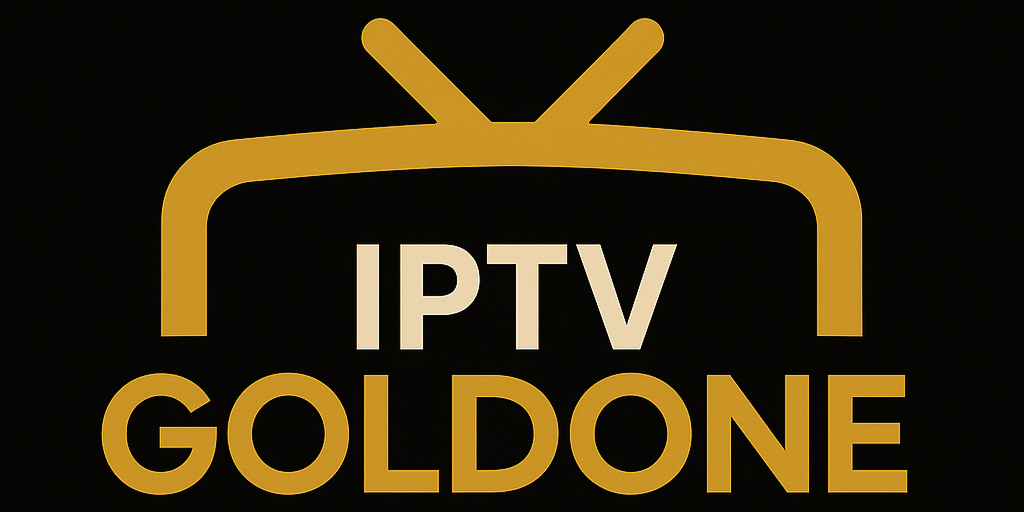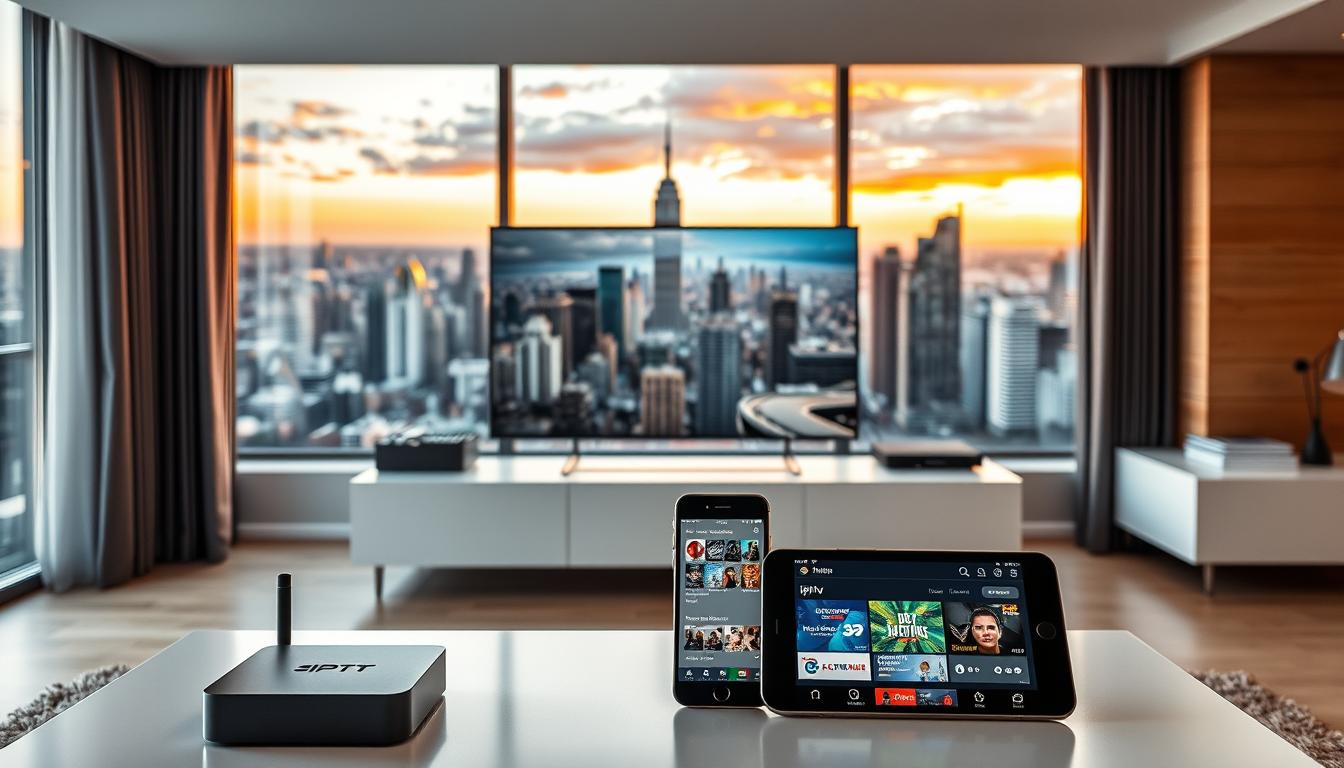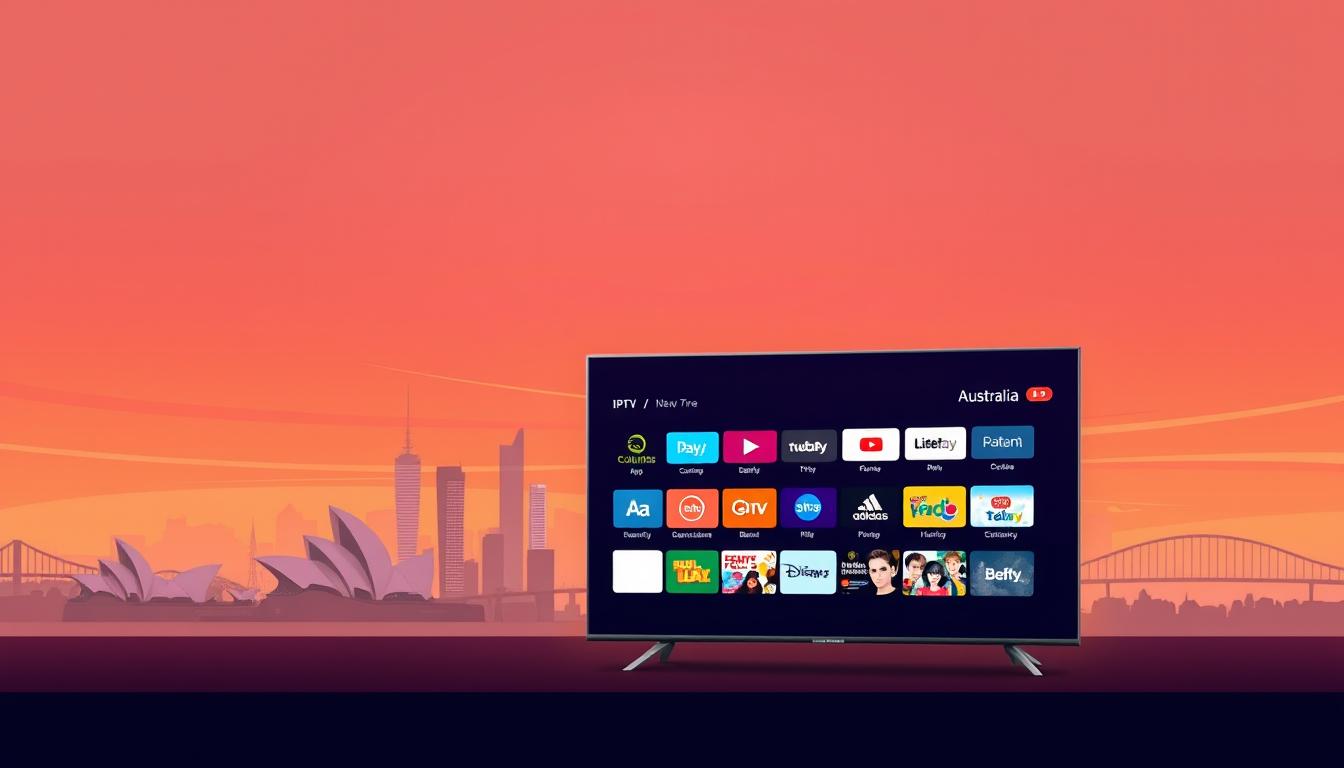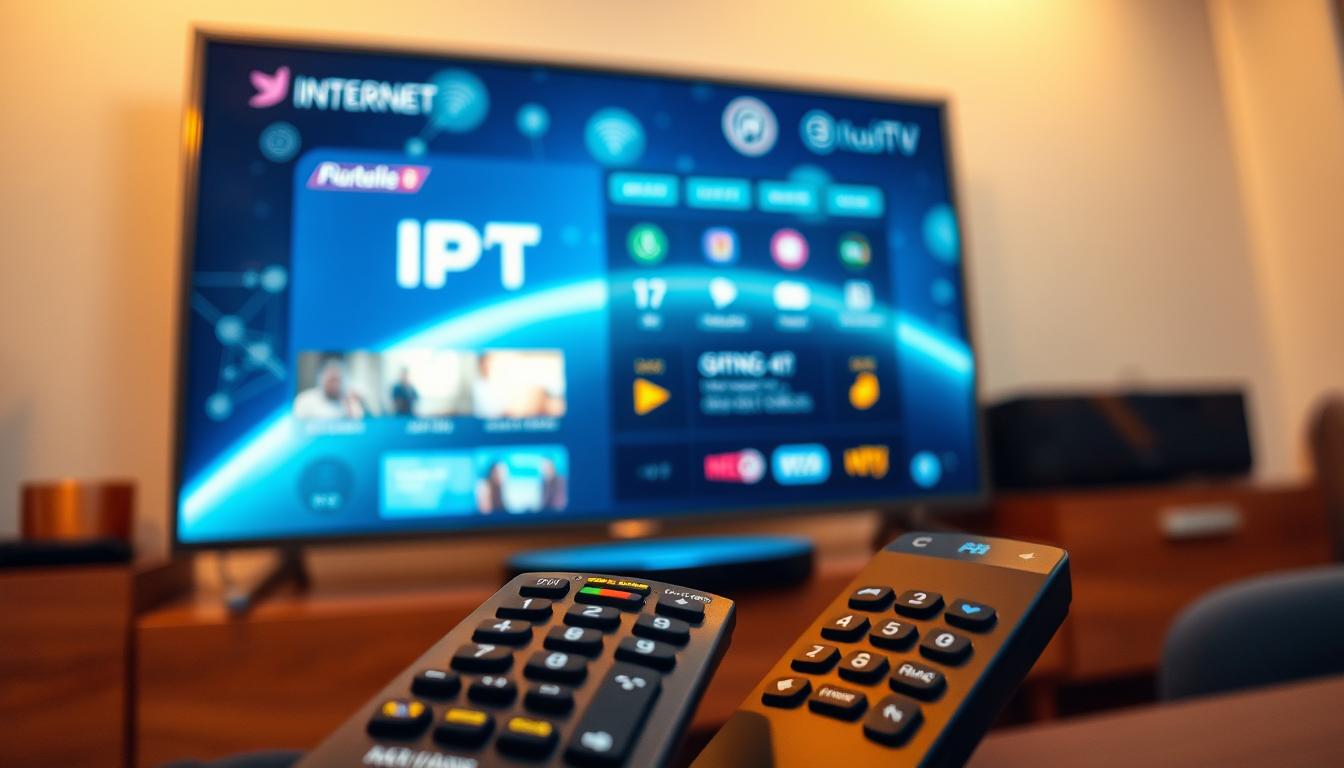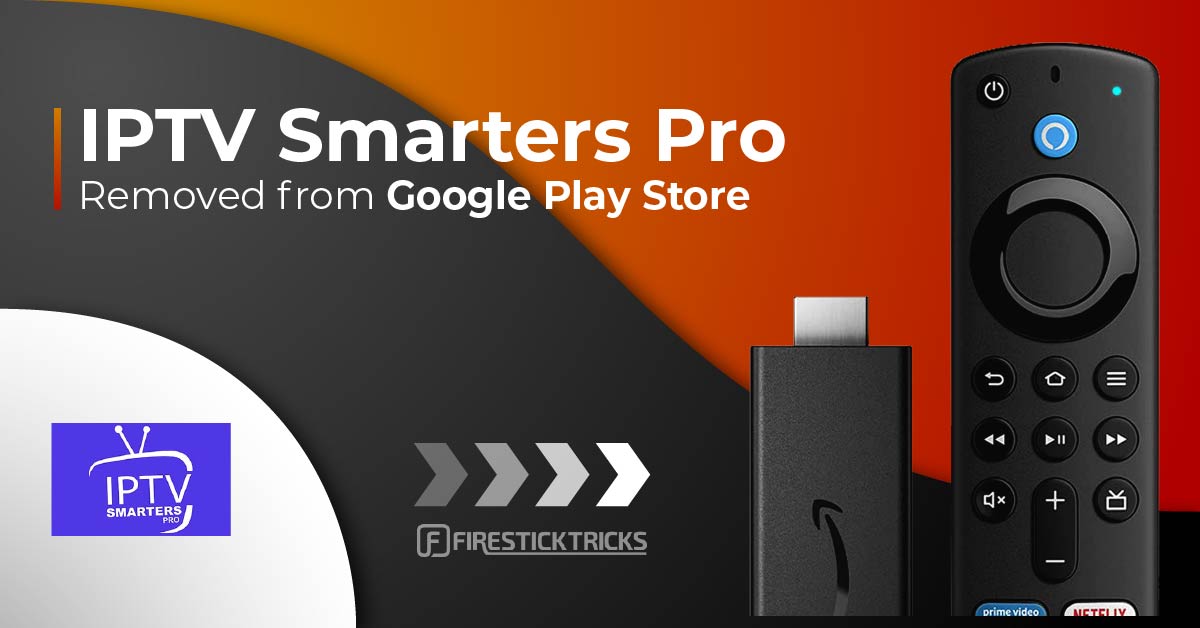Discover What IPTV Is and How It Works
IPTV, or Internet Protocol Television, is changing how we watch TV. It sends TV shows over the internet. This makes watching TV more personal and flexible, changing TV forever.
IPTV technology lets users watch a lot of TV content online. This includes live TV, videos on demand, and more. It’s making old TV ways less popular.
Looking to get started with IPTV? Check out IPTVGoldOne.com — your trusted source for premium IPTV service in Australia.

Knowing what IPTV definition is helps us see its big impact. IPTV mixes TV and internet, giving us a better viewing experience.
Key Takeaways
- IPTV delivers television content over the internet.
- It offers a personalized and flexible viewing experience.
- IPTV technology includes live TV, on-demand videos, and interactive services.
- It is changing the traditional television broadcasting landscape.
- Understanding IPTV is key to appreciating its impact on modern television.
What Is IPTV? Understanding the Basics
IPTV is a new way to watch TV over the internet. It’s different from old TV watching methods. It brings a fresh twist to how we enjoy TV shows and movies.
For a high-quality experience, consider a reliable IPTV provider like IPTVGoldOne, offering 4K streaming, sports packages, and global channels.
IPTV Definition and Core Concept
IPTV means watching TV over the internet. It includes live TV, movies on demand, and more. It uses the internet to send content straight to your devices.
This method lets you watch what you want, when you want. You can use it on smart TVs, phones, and tablets. It’s all about personal choice and flexibility.
How IPTV Differs from Traditional TV and Streaming Services
IPTV is not like old TV or streaming services. It uses the internet to send content. This means you can watch live TV or on-demand shows.
It also has more channels and content than many streaming services. Netflix is great for movies, but IPTV has live TV too. It’s a mix of old TV and new streaming.
In short, IPTV is a modern TV service. It sends a wide range of content over the internet. It’s flexible, personal, and has lots of content. It’s a great choice for watching TV today.
The Technology Behind IPTV
IPTV technology is changing how we watch TV. It’s clear that internet protocol fundamentals are key to how it works.
Internet Protocol Fundamentals
The internet protocol (IP) is at the heart of IPTV. It lets TV content stream over the internet. IP networks are perfect for this because they handle data well. This setup makes it possible for features like video on demand and interactive TV.
Streaming vs. Downloading Content
IPTV is great because it streams content right to your device. This is different from downloading, where you have to wait for the whole file. Streaming means you can start watching right away, without needing a lot of storage.
Streaming is also key for live events. It lets IPTV services show live TV without delay.
Video Compression and Transmission Methods
IPTV uses video compression methods to keep things smooth. These methods make video files smaller, so they’re easier to send over the internet. H.264 and H.265 are two common ones used.
When IPTV sends content, it breaks it into small data packets. These packets are sent over the IP network. Then, they’re put back together at your device, so you get high-quality content.
How Does IPTV Work?
IPTV works through a complex process with several key parts.
IPTV sends TV content over the internet. It uses Internet Protocol (IP) to stream media to users.
The Complete IPTV Delivery Process
The IPTV process begins with content aggregation. Here, channels and video on demand (VOD) content are gathered and prepared for distribution.
This content is then encoded and compressed. This makes sure it streams smoothly over the internet.
The encoded content is sent through a content delivery network (CDN). This is a network of servers in different places.
Content Storage and Distribution Networks
Content storage and distribution are key in IPTV.
IPTV providers use strong storage solutions. They store a lot of content, which is then sent through their CDN.
The CDN makes sure content reaches users quickly and with little buffering.
| Component | Function | Importance |
|---|---|---|
| Content Aggregation | Gathering and preparing content for distribution | High |
| Content Encoding | Compressing content for smooth transmission | High |
| Content Delivery Network (CDN) | Distributing content across different locations | Critical |
End-User Reception and Playback Mechanisms
Users get IPTV content on various devices. These include IPTV set-top boxes, smart TVs, and mobile devices.
These devices use IPTV applications or software to play back the content. A stable internet connection is key for smooth playback and to avoid buffering.
Types of IPTV Services Available in Australia
IPTV services in Australia come in different types. Each offers unique features and benefits. Knowing these options helps you pick the best service for your viewing needs.
Video on Demand (VOD) Services
Video on demand services let users watch a huge library of content anytime. This includes movies, TV shows, and documentaries. You can browse, read descriptions, and watch what you want, when you want.
Some IPTV providers in Australia have huge VOD libraries. These libraries are always growing with new titles and genres. You can search for specific titles or get recommendations based on what you’ve watched before.

Live IPTV Broadcasting Options
Live IPTV broadcasting gives users real-time access to TV channels, sports, and news. It’s perfect for staying current or watching live sports without delay.
Some IPTV services stream live content with high quality and little buffering. This means you can watch your favorite TV channels or live events from home without interruption.
Time-Shifted Media and Catch-Up TV
Time-shifted media and catch-up TV let you watch shows or events that aired earlier. It’s great for those who miss their favorite TV shows or want to see a past event.
Some IPTV providers offer catch-up services. This lets you watch TV shows or events from a few days ago. It adds flexibility to your viewing schedule, so you can watch content at a better time for you.
Essential Hardware and Software for IPTV Setup
To enjoy IPTV without hitches, knowing the right hardware and software is key. The correct gear ensures you can watch your favorite shows and movies smoothly.
IPTV Set-Top Boxes and Devices
IPTV set-top boxes are vital for decoding and showing IPTV streams on your TV. They come in different models, each with unique features.
Popular Models in the Australian Market
In Australia, top IPTV set-top boxes include models from well-known brands. These offer high-quality streaming and extra features like voice control and support for multiple devices.
- Formuler Z8: Known for its high performance and support for various IPTV services.
- Mag 250: Offers a robust IPTV experience with a user-friendly interface.
Smart TVs and IPTV Applications
Many modern smart TVs have built-in IPTV apps or support IPTV services through downloadable apps. This makes watching TV more convenient.
Some smart TV brands that support IPTV include:
- Samsung
- LG
- Sony
Network Requirements for Optimal Performance
A stable and fast internet connection is essential for a smooth IPTV experience. You need the right type of internet and a minimum speed.
Internet Speed Recommendations
For SD IPTV, a 5 Mbps internet speed is recommended. HD IPTV needs at least 15 Mbps, and 4K content requires 25 Mbps or more.
| Content Type | Recommended Internet Speed |
|---|---|
| SD (Standard Definition) | 5 Mbps |
| HD (High Definition) | 15 Mbps |
| 4K (Ultra High Definition) | 25 Mbps |
Setting Up Your IPTV Service: Step-by-Step Guide
In this section, I’ll guide you through setting up your IPTV service. It involves several key steps for the best viewing experience.
Choosing the Right IPTV Provider
The first step is to pick a reliable IPTV provider. There are many providers, so compare their channels, prices, and support. Choose one with lots of channels and good customer reviews.
Subscription and Account Creation
After picking your provider, subscribe and create an account. Visit their website, choose a plan, and enter your details. You’ll get login info to access the service.
Use a strong password and keep your login safe to avoid unauthorized access.
Device Configuration and App Installation
Next, set up your device and install the IPTV app. Most services work on smart TVs, phones, and IPTV boxes. Download the app, log in, and follow the setup instructions.

Testing and Optimizing Your Setup
Finally, test your IPTV setup. Make sure you can access all channels and the video quality is good. If there are problems, like buffering, try improving your internet or adjusting your device settings.
By following these steps, you’ll enjoy a great IPTV experience. The key is to choose the right provider and ensure your devices are set up right.
Popular IPTV Providers in Australia
IPTV is becoming more popular in Australia. Several key providers lead the market. They offer services that meet different viewer needs.
Legal IPTV Services Available Nationwide
Australia has many legal IPTV services across the country. Fetch TV and Telstra TV are well-known. They provide a variety of channels and content.
These services include on-demand options. This lets viewers watch their favorite shows and movies whenever they want.
Comparing Features, Channel Offerings, and Pricing
Choosing an IPTV provider requires comparing features, channels, and prices. Providers offer different packages. Some focus on sports, movies, or general entertainment.
- Fetch TV has various packages, including lots of on-demand content.
- Telstra TV offers many channels, including sports and entertainment.
- Optus also provides competitive IPTV services with many channel options.
Australian Content Availability
Availability of local content is key for Australian viewers. IPTV providers meet this need with Australian channels. These include news, sports, and entertainment.
Many services include ABC, SBS, and sports channels. They show local and international events.
Understanding what different IPTV providers offer helps viewers choose their TV options wisely.
Troubleshooting Common IPTV Issues
Understanding common IPTV problems helps users fix issues fast. IPTV, like other streaming services, faces technical issues that affect viewing. Knowing these can improve your experience.
Common issues include buffering, playback problems, connection errors, and picture and audio sync issues. To solve these, it’s important to know about IPTV technology and what affects it.
Buffering and Playback Problems
Buffering and playback issues are frustrating for IPTV users. They can stem from a slow internet, busy servers, or device or app problems.
To fix buffering, check your internet speed. Make sure it’s good enough for IPTV streaming. Try restarting your device or app, or switch servers if you can.
Connection and Authentication Errors
Connection and authentication errors block access to IPTV services. These often relate to account or subscription issues, or server problems.
To solve these, check your subscription and account details. Restart your device or app. If needed, contact your IPTV provider’s support.
Picture Quality and Audio Sync Issues
Poor picture quality and audio sync issues ruin the viewing experience. They can result from internet issues, device or app problems, or video stream issues.
To improve picture quality, check your internet and device or app settings. Try adjusting video settings or switching stream quality if possible.
For audio sync issues, check your device or app’s audio settings. Ensure audio isn’t delayed or out of sync with video.
The Benefits of Using IPTV in Australia
IPTV brings a more personalized and accessible viewing experience to Australians. It offers many benefits over traditional TV services.
Content Flexibility and Customization Options
IPTV stands out for its flexibility and customization. Unlike traditional TV, IPTV lets users pick from a wide range of channels and on-demand content. This way, they can tailor their viewing to their liking.
Some of the key features that offer content flexibility include:
- On-demand access to a vast library of content
- Ability to pause, rewind, and fast-forward live TV
- Customizable channel lineups
Cost-Effectiveness Compared to Cable and Satellite
IPTV is also more budget-friendly than cable and satellite TV. Users can pick from various subscription plans that match their budget. There are no hidden fees or long-term contracts.
A comparison of IPTV costs with traditional TV services is shown in the table below:
| Service | Monthly Cost | Contract Length |
|---|---|---|
| IPTV | $12 – $15 | No contract |
| Cable TV | $50-$100 | 12-24 months |
| Satellite TV | $60-$150 | 12-24 months |
Multi-Device Accessibility and Viewing Experience
IPTV allows users to watch their favorite shows on various devices. This includes smartphones, tablets, smart TVs, and set-top boxes.
The benefits of multi-device accessibility include:
- Watch TV on the go
- Stream content on multiple devices at once
- Seamless viewing experience across devices
Get Started with IPTV Today
Ready to explore the future of television?
Visit IPTVGoldOne.com to get instant access to:
- Over 20,000 global channels
- Premium sports and movie packages
- 24/7 customer support
- Fast setup and smooth streaming
- Whether you’re in Sydney, Melbourne, or anywhere across Australia, IPTVGoldOne delivers the best in internet-based TV — right to your screen.
Conclusion
IPTV technology is changing how we watch TV in Australia. It lets us understand IPTV better and choose how we watch TV.
IPTV offers many benefits like flexibility, cost savings, and watching on different devices. It’s a great choice compared to old TV services. You can pick what you want to watch, from on-demand videos to live shows.
IPTV is growing and will be key in TV’s future in Australia. It brings a new way to watch TV, making it more personal and fun. This change is big for how we enjoy TV today.
FAQ
What is IPTV, and how does it differ from traditional TV?
What are the benefits of using IPTV services?
How do I set up my IPTV service?
What are the essential hardware and software requirements for IPTV?
What is the difference between streaming and downloading content on IPTV?
How do I troubleshoot common IPTV issues such as buffering and playback problems?
Are IPTV services available in Australia?
Can I access IPTV on multiple devices?
Staying updated with best practices is crucial. If buffering persists, here’s how to fix IPTV buffering problems.
Table of Contents
You Might Like:
© 2023 All rights Reserved. iptvgoldone.com
